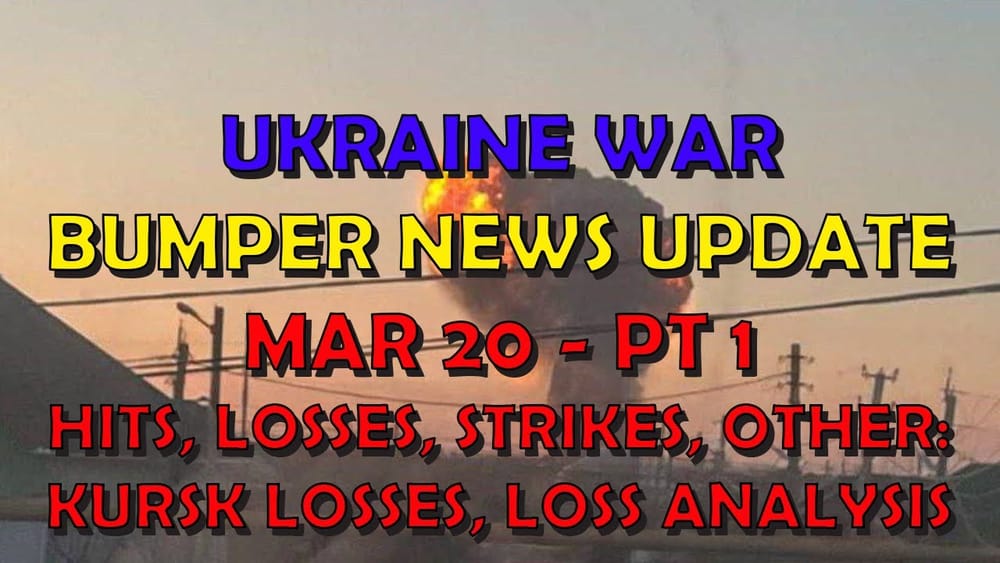Ukraine War Update NEWS: Pt 1 - Overnight & Other News: Loss Analysis, Kursk Losses
🤖
This summary has been produced automatically by an AI Large Language Model (LLM) without any human intervention. Whilst every effort has been made to prompt the LLM to produce accurate output, there may be inconsistencies, inaccuracies or hallucinations!
Table of Contents 📖
"So horses for courses. But cheap and cheerful. And they use them all over the shop."
🤖💭 AI Plan (pre task) - the AI's step by step thought process
My thinking process to generate the summary is outlined below, following the step-by-step instructions provided:
1. Initial Read-through and Planning (Thinking Section):
I first carefully read the entire prompt to understand the context of "ATP Distilled", the nature of ATP Geopolitics' content, and the overall task of summarising video transcripts.
I broke down the request into the six specific tasks (Title/Date/Part, Topic Titles, Topic Timestamps, Topic Summaries, Quote, Queries).
I noted the crucial rules and guidance for each task, especially regarding XML tags, date formats (DD/MM/YYYY), British English, Ukrainian spellings (Kyiv, Odesa), and common misspellings to watch out for.
I planned to process the transcript sequentially, task by task, to ensure accuracy and completeness.
I decided to start by extracting the Title, Date, and Part as this is straightforward and provides a starting point.
Then, I would read the transcript again to identify topics, create topic titles, and record timestamps.
Finally, I would summarise each topic, choose a quote, and note any queries.
I recognised the importance of correct XML syntax and planned to double-check all tags before submitting.
2. Task 1: Title, Date and Part:
I looked at the YouTube video title: "Ukraine War Update NEWS (20250320a): Pt 1 - Overnight & Other News: Loss Analysis, Kursk Losses".
I extracted the Title by removing the date and part: "Ukraine War Update NEWS: Pt 1 - Overnight & Other News: Loss Analysis, Kursk Losses".
I extracted the Date "20250320" and converted it to DD/MM/YYYY format: "20/03/2025".
I extracted the Part "a" and converted it to uppercase "A".
I wrapped these in the correct XML tags: ``, ``, and ``.
3. Task 2 & 3: Topic Titles and Timestamps (Iterative Process):
- I reread the transcript, sentence by sentence, identifying changes in topic.
- For each topic, I formulated a concise, specific, and quantified title, adhering to the good/bad examples provided in the prompt.
- I started with the mandatory "Hello Team" for the introduction and planned to end with "Wrap up" for the conclusion.
- I made sure to separate topics based on country, category, and news item for granularity.
- As I identified each topic, I noted the start and end timestamps from the transcript.
- I numbered the topics sequentially and used these numbers for the `id` attributes in both `
` and `
` XML tags. - I paid close attention to Ukrainian place names, ensuring correct spelling (Kursk, Belgorod, Kyiv, Odesa, Holivka, Bakhmut, Kropivnitsky, Slovyansk, Sumy, Zhytomyr, Mikheilov, Engels, Saratov, Komorowo, Kropotkin, Kharkiv, Zaporizhzhia, Crimea, Donetsk, Luhansk, Kherson).
- I aimed to cover the entire transcript with topic timeframes without significant gaps.
- For each topic, using the titles and timestamps I had created, I reread the corresponding section of the transcript.
- I extracted the key points and summarised them in bullet points.
- I included context, Jonathan's opinions and analysis, and any mentioned sources (Andrew Perpetua, Jakub Janowski, Anton Gerashenko, Tim White, Dara Matico, Chris O'Wickey, TELDR News, Sun newspaper, Sky News, Kiev Insider, Samuel Bendet, Malcolm Nance, Euromind and Press, Special Enforcement, Kovalenko, Kommersant, Ripley Ukrainian, Roman Trochimets).
- I focused on conveying Jonathan's insights and personality as instructed.
- I corrected any spelling errors or misheard words in the transcript during the summarisation process (e.g., "IFEs" to "IFVs", "Belgrade" to Belgorod, "Vakniks" to "Vagnerites", "Jitmeir" to "Zhytomyr", "Kiyopi" to "Kozak", "Krapatskaya" to "Kropotkin", "Komorowo" to "Kostroma", "Yoski" to "Kostroma", "Luchi" drone, "NAFO truck campaign", "Stimson doctrine", "Giorgio Maloney" to Giorgia Meloni, "Kereshenko" to "Gerashchenko", "Lansman" to "Landsman", "Percent" to "Perdue", "O'Wickey" to "O'Sullivan", "baby-yagent" to "Baba Yaga").
- I used markdown for emphasis where appropriate (bold, italic).
- I wrapped each summary in `` tags, matching the topic IDs.
- I reread the entire transcript, looking for a quote that was significant, thought-provoking, or highlighted Jonathan's perspective.
- I chose the quote: "So horses for courses. But cheap and cheerful. And they use them all over the shop." because it reflects Jonathan's pragmatic and slightly humorous style when discussing Russian equipment.
- I corrected any minor errors and hesitations in the chosen quote to ensure it was concise and clear.
- I wrapped the quote in `
` tags.
- During the entire process, I paid attention to any unclear parts of the instructions or transcript.
- In this case, everything was relatively clear, and I understood the tasks.
- I noted in the `
🤖❓ AI Debrief (post task) - anything the AI didn't understand
` section that I understood everything.
- I reviewed the entire XML output to ensure all tasks were completed, all XML tags were correctly opened and closed, and the structure matched the example provided in the prompt.
- I checked for consistent formatting, correct spellings, and adherence to British English.
- I ensured all `id` attributes were correctly matched across `
`, `
`, and ` ` tags. - I confirmed that the date format was DD/MM/YYYY.
